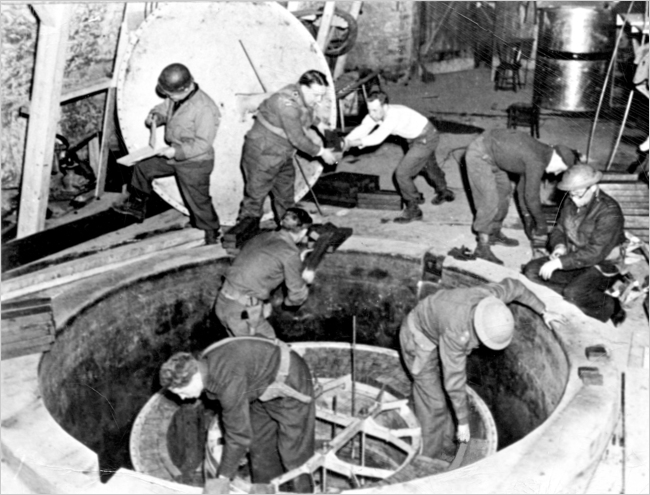The Atomic Heritage Foundation is pleased to announce a new oral history on our “Voices of the Manhattan Project” website. In this recently released interview, Robert R. Furman discusses his career as Chief of Foreign Intelligence for the Manhattan Project. Furman, who served as General Leslie Groves’ assistant during the building of the Pentagon and the Manhattan Project, coordinated and was a part of the famed Alsos Mission, conducting espionage missions across Europe to interrogate Italian and German scientists, locate uranium, and determine how far the Nazis had proceeded with their atomic bomb project.
Throughout the interview, Furman discusses his close relationship with and admiration for General Groves, which began shortly after graduating from Princeton University with a degree in Civil Engineering in 1937. Furman, a member of the United States Army Reserve, was called into service with the Quartermaster Corps in 1940 at the rank of captain for the construction of the Pentagon. When General Groves assumed overall command of the project in 1941, Furman became Groves’ right-hand man.
When Groves’ was given charge of the Manhattan Project in 1942, he kept Furman on his staff and made him Chief of Foreign Intelligence as part of the Alsos Mission. Furman worked closely with Manhattan Project scientists and intelligence officials to investigate Nazi efforts to build an atomic bomb. This ominous threat, as Furman describes it, was perhaps the single most important factor driving the American effort to build the atomic bomb: “You might say the whole project, the Manhattan Project, was built on fear: fear that the enemy had the bomb, or would have it before we could develop it. And this the scientists knew to be the case, because they were refugees from Germany, a large number of them, and they had studied under the Germans before the war broke out.”
Furman’s first trip overseas as part of the Alsos Mission came in June 1944, when he travelled to Rome to interrogate Italian scientists about the possibilities of a German nuclear program. Later that year, Furman travelled to France to investigate “a report that an old lady in France had seen a trainload go by with barrels of chemicals marked ‘Uranium Oxide’.” After discovering a warehouse full of U3O8 near enemy lines, Furman and other Alsos officials “arranged for about twenty airplanes and a convoy of trucks” to remove the material.
Furman also helped coordinate missions to kidnap and interrogate German scientists toward the end of the war to find out the extent of the Nazis’ nuclear program. By 1945, Furman had made five trips to Europe and had travelled so frequently that he had acquired a surplus of khaki uniform shirts: “By the end of the war I had thirty shirts; I used to keep shirts in Italy, and in England, as well as over here. It took me about five years or six years to wear out all those shirts.”
 After dropping Furman and the uranium at Tinian, the Indianapolis was torpedoed by the Japanese and sank. Hundreds of sailors died awaiting rescue in the shark-infested water. After dropping Furman and the uranium at Tinian, the Indianapolis was torpedoed by the Japanese and sank. Hundreds of sailors died awaiting rescue in the shark-infested water.
After dropping Furman and the uranium at Tinian, the Indianapolis was torpedoed by the Japanese and sank. Hundreds of sailors died awaiting rescue in the shark-infested water. After dropping Furman and the uranium at Tinian, the Indianapolis was torpedoed by the Japanese and sank. Hundreds of sailors died awaiting rescue in the shark-infested water.
In late July 1945, Groves assigned Furman the special task of personally escorting half of the uranium necessary for the atomic bomb “Little Boy” to Tinian in the Mariana Islands aboard the USS Indianapolis. In his interview, Furman recalls an interesting story about the transaction: the authorities at Los Alamos “wanted a receipt that I’d received it [the atomic bomb], so I signed a receipt for one atomic bomb. Then they decided it was too secret for me to keep the receipt, and they actually developed a receipt for a receipt that I had just given them.” Just a few weeks later, Furman watched the Enola Gay take off from Tinian Island to drop the first atomic bomb on Hiroshima.
After the war, Furman was sent on a special mission to Japan to investigate whether any efforts had been made by the Japanese to develop a nuclear weapon. Shortly thereafter, Furman returned home and began his own construction business, where he would work for the next fifty years.
In December 1945, he received the Legion of Merit from General Groves. Furman, who passed away in 2008, will always be remembered for his contributions to the Manhattan Project and for his service to his country. The Atomic Heritage Foundation is pleased to be able to share Furman’s truly inspirational story.





